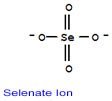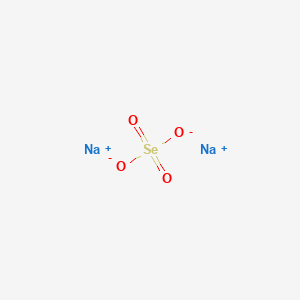SECTION 1. IDENTIFICATION
Product Name: Sodium Selenate, Anhydrous
Product Number: All applicable American Elements product codes, e.g. NA-SEAT-02-C.AHYD
, NA-SEAT-025-C.AHYD
, NA-SEAT-03-C.AHYD
, NA-SEAT-035-C.AHYD
, NA-SEAT-04-C.AHYD
, NA-SEAT-05-C.AHYD
CAS #: 13410-01-0
Relevant identified uses of the substance: Scientific research and development
Supplier details:
American Elements
10884 Weyburn Ave.
Los Angeles, CA 90024
Tel: +1 310-208-0551
Fax: +1 310-208-0351
Emergency telephone number:
Domestic, North America: +1 800-424-9300
International: +1 703-527-3887
SECTION 2. HAZARDS IDENTIFICATION
2.1. Classification of the substance or mixture
Classification under CLP: Acute Tox. 3: H331; Acute Tox. 4: H302; Aquatic Chronic 2: H411; STOT RE 2: H373
Most important adverse effects: Harmful if swallowed. Toxic if inhaled. May cause damage to organs through prolonged
or repeated exposure. Toxic to aquatic life with long lasting effects.
2.2. Label elements
Label elements:
Hazard statements: H302: Harmful if swallowed.
H331: Toxic if inhaled.
H373: May cause damage to organs through prolonged or repeated exposure.
H411: Toxic to aquatic life with long lasting effects.
Signal words: Danger
Hazard pictograms: GHS06: Skull and crossbones
GHS08: Health hazard
GHS09: Environmental
Precautionary statements: P260: Do not breathe dust/fumes/gas/mist/vapors/spray.
P271: Use only outdoors or in a well-ventilated area.
P301+310: IF SWALLOWED: Immediately call a POISON CENTER/doctor/.
P311: Call a POISON CENTER/doctor/.
P314: Get medical advice/attention if you feel unwell.
P321: Specific treatment (see on this label).
2.3. Other hazards
PBT: This product is not identified as a PBT/vPvB substance.
SECTION 3. COMPOSITION/INFORMATION ON INGREDIENTS
3.2. Mixtures
Hazardous ingredients:
SODIUM SELENATE
EINECS CAS PBT / WEL CLP Classification Percent
236-501-8 13410-01-0 - Acute Tox. 3: H301; Aquatic Chronic 1:
H410; STOT RE 2: H373; Aquatic
Acute 1: H400; Acute Tox. 3: H331
1-10%
SECTION 4. FIRST AID MEASURES
4.1. Description of first aid measures
Skin contact: Remove all contaminated clothes and footwear immediately unless stuck to skin.
Drench the affected skin with running water for 10 minutes or longer if substance is still
on skin. Transfer to hospital if there are burns or symptoms of poisoning.
Eye contact: Bathe the eye with running water for 15 minutes. Transfer to hospital for specialist
examination.
Ingestion: Wash out mouth with water. Do not induce vomiting. If conscious, give half a litre of water
to drink immediately. If unconscious, check for breathing and apply artificial respiration if
necessary. If unconscious and breathing is OK, place in the recovery position. Transfer
to hospital as soon as possible.
Inhalation: Remove casualty from exposure ensuring one's own safety whilst doing so. If
conscious, ensure the casualty sits or lies down. If unconscious and breathing is OK,
place in the recovery position. If unconscious, check for breathing and apply artificial
respiration if necessary. If breathing becomes bubbly, have the casualty sit and provide
oxygen if available. Transfer to hospital as soon as possible.
4.2. Most important symptoms and effects, both acute and delayed
Skin contact: There may be redness or whiteness of the skin in the area of exposure.
Eye contact: There may be irritation and redness. The eyes may water profusely.
Ingestion: There may be soreness and redness of the mouth and throat. Ingestion of (excessive
amounts) may cause vomiting, nausea, convulsions. There may be loss of
consciousness.
Inhalation: There may be respiratory irritation. Harmful by inhalation
Delayed / immediate effects: Immediate effects can be expected after short-term exposure.
4.3. Indication of any immediate medical attention and special treatment needed
Immediate / special treatment: Immediate medical attention is required. Show this safety data sheet to the doctor in
attendance.
SECTION 5. FIREFIGHTING MEASURES
5.1. Extinguishing media
Extinguishing media: Suitable extinguishing media for the surrounding fire should be used. Use water spray
to cool containers.
5.2. Special hazards arising from the substance or mixture
Exposure hazards: Non combustible. In ambient fire the product will release toxic fumes and oxides of
Selenium.
5.3. Advice for fire-fighters
Advice for fire-fighters: Wear self-contained breathing apparatus. Wear protective clothing to prevent contact
with skin and eyes.
SECTION 6. ACCIDENTAL RELEASE MEASURES
6.1. Personal precautions, protective equipment and emergency procedures
Personal precautions: Notify the police and fire brigade immediately. If outside do not approach from
downwind. If outside keep bystanders upwind and away from danger point. Mark out the
contaminated area with signs and prevent access to unauthorised personnel. Do not
attempt to take action without suitable protective clothing - see section 8 of SDS. Do not
create dust.
6.2. Environmental precautions
Environmental precautions: Do not discharge into drains or rivers.
6.3. Methods and material for containment and cleaning up
Clean-up procedures: Clean-up should be dealt with only by qualified personnel familiar with the specific
substance. Transfer to a closable, labelled salvage container for disposal by an
appropriate method.
6.4. Reference to other sections
Reference to other sections: Refer to section 8 of SDS.
SECTION 7. HANDLING AND STORAGE
7.1. Precautions for safe handling
Handling requirements: Avoid direct contact with the substance. Ensure there is exhaust ventilation of the area.
Avoid the formation or spread of dust in the air.
7.2. Conditions for safe storage, including any incompatibilities conditions: Store in a cool, well ventilated area. Keep container tightly closed. The floor of the
storage room must be impermeable to prevent the escape of liquids.
Suitable packaging: Must only be kept in original packaging.
7.3. Specific end use(s)
Specific end use(s): No data available.
SECTION 8. EXPOSURE CONTROLS/PERSONAL PROTECTION
8.1. Control parameters
Hazardous ingredients:
SODIUM SELENATE
Workplace exposure limits: Respirable dust
State 8 hour TWA 15 min. STEL 8 hour TWA 15 min. STEL
UK 0.1 mg/m3 - - -
DNEL/PNEC Values
DNEL / PNEC No data available.
8.2. Exposure controls
Engineering measures: Ensure there is exhaust ventilation of the area. The floor of the storage room must be
impermeable to prevent the escape of liquids.
Respiratory protection: Self-contained breathing apparatus must be available in case of emergency. Particle
filter class P1 (EN143).
Hand protection: Protective gloves.
Eye protection: Safety glasses with side-shields. Ensure eye bath is to hand.
Skin protection: Protective clothing.
Environmental: No special requirement.
SECTION 9. PHYSICAL AND CHEMICAL PROPERTIES
9.1. Information on basic physical and chemical properties
State: Powder
Colour: White
Odor: Odorless
Evaporation rate: No data available.
Oxidising: Non-oxidising (by EC criteria)
Solubility in water: Soluble
Viscosity: No data available.
Boiling point/range°C: No data available. Melting point/range°C: No data available.
Flammability limits %: lower: No data available. upper: No data available.
Flash point°C: No data available. Part.coeff. n-octanol/water: No data available.
Autoflammability°C: No data available. Vapor pressure: No data available.
Relative density: No data available. pH: No data available.
VOC g/l: No data available.
9.2. Other information
Other information: No data available.
SECTION 10. STABILITY AND REACTIVITY
10.1. Reactivity
Reactivity: Stable under recommended transport or storage conditions.
10.2. Chemical stability
Chemical stability: Stable under normal conditions.
10.3. Possibility of hazardous reactions
Hazardous reactions: Hazardous reactions will not occur under normal transport or storage conditions.
Decomposition may occur on exposure to conditions or materials listed below.
10.4. Conditions to avoid
Conditions to avoid: Heat.
10.5. Incompatible materials
Materials to avoid: Strong oxidising agents. Strong acids.
10.6. Hazardous decomposition products
Haz. decomp. products: In combustion emits toxic fumes.
SECTION 11. TOXICOLOGICAL INFORMATION
11.1. Information on toxicological effects
Hazardous ingredients:
SODIUM SELENATE
ORAL RAT LD50 1.6 mg/kg
Relevant hazards for substance:
Hazard Route Basis
Acute toxicity (ac. tox. 4) ING Hazardous: calculated
Acute toxicity (ac. tox. 3) INH Hazardous: calculated
STOT-repeated exposure - Hazardous: calculated
Symptoms / routes of exposure
Skin contact: There may be redness or whiteness of the skin in the area of exposure.
Eye contact: There may be irritation and redness. The eyes may water profusely.
Ingestion: There may be soreness and redness of the mouth and throat. Ingestion of (excessive
amounts) may cause vomiting, nausea, convulsions. There may be loss of
consciousness.
Inhalation: There may be respiratory irritation. Harmful by inhalation
Delayed / immediate effects: Immediate effects can be expected after short-term exposure.
SECTION 12. ECOLOGICAL INFORMATION
12.1. Toxicity
Hazardous ingredients:
SODIUM SELENATE
ALGAE 72H ErC50 96.6 mg/l
Daphnia magna 48H EC50 7.9 mg/l
ZEBRAFISH (Brachydanio rerio) 96H LC50 24 mg/l
12.2. Persistence and degradability
Persistence and degradability: No data available.
12.3. Bioaccumulative potential
Bioaccumulative potential: No data available.
12.4. Mobility in soil
Mobility: Soluble in water.
12.5. Results of PBT and vPvB assessment
PBT identification: This product is not identified as a PBT/vPvB substance.
12.6. Other adverse effects
Other adverse effects: Toxic to aquatic organisms. Toxic to soil organisms.
SECTION 13. DISPOSAL CONSIDERATIONS
13.1. Waste treatment methods
Disposal operations: Transfer to a suitable container and arrange for collection by specialised disposal
company.
NB: The user's attention is drawn to the possible existence of regional or national
regulations regarding disposal.
SECTION 14. TRANSPORT INFORMATION
14.1. UN number
UN number: UN3288
14.2. UN proper shipping name
Shipping name: TOXIC SOLID, INORGANIC, N.O.S.
(SODIUM SELENATE)
14.3. Transport hazard class(es)
Transport class: 6.1
14.4. Packing group
Packing group: III
14.5. Environmental hazards
Environmentally hazardous: Yes Marine pollutant: No
14.6. Special precautions for user
Special precautions: No special precautions.
Tunnel code: E
Transport category: 2
SECTION 15. REGULATORY INFORMATION
REACH No. : A registration number is not available for this substance as the substance or its uses are
exempted from registration, the annual tonnage does not require a registration or the registration is
envisaged for a later registration deadline.
SARA 302 Components
The following components are subject to reporting levels established by SARA Title III, Section 302:
Sodium selenate CAS-No. 13410-01-0
SARA 313 Components
The following components are subject to reporting levels established by SARA Title III, Section 313:
Sodium selenate CAS-No. 13410-01-0
SARA 311/312 Hazards
Acute Health Hazard, Chronic Health Hazard
Massachusetts Right To Know Components
Sodium selenate CAS-No. 13410-01-0
Pennsylvania Right To Know Components
Sodium selenate CAS-No. 13410-01-0
New Jersey Right To Know Components
Sodium selenate CAS-No. 13410-01-0
California Prop. 65 Components
This product does not contain any chemicals known to State of California to cause cancer, birth defects,
or any other reproductive harm.
SECTION 16. OTHER INFORMATION
Safety Data Sheet according to Regulation (EC) No. 1907/2006 (REACH). The above information is believed to be correct but does not purport to be all inclusive and shall be used only as a guide. The information in this document is based on the present state of our knowledge and is applicable to the product with regard to appropriate safety precautions. It does not represent any guarantee of the properties of the product. American Elements shall not be held liable for any damage resulting from handling or from contact with the above product. See reverse side of invoice or packing slip for additional terms and conditions of sale. COPYRIGHT 1997-2022 AMERICAN ELEMENTS. LICENSED GRANTED TO MAKE UNLIMITED PAPER COPIES FOR INTERNAL USE ONLY.

 See more Selenium products.
See more Selenium products. One of the most common uses for selenium is in
One of the most common uses for selenium is in  See more Sodium products.
See more Sodium products.
